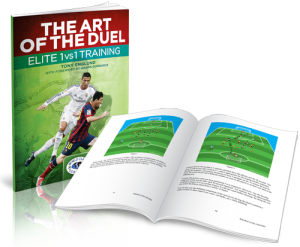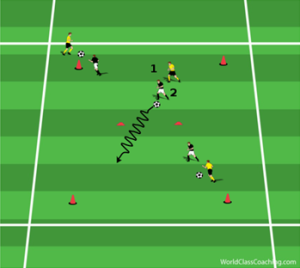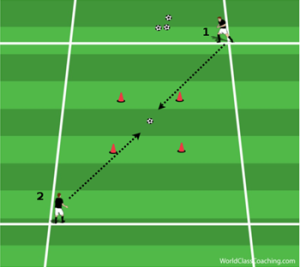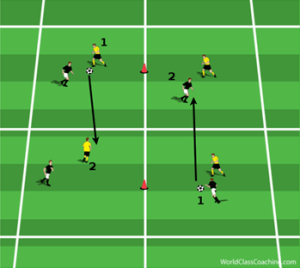These 1 v 1 exercises are from our latest book by Tony Englund, 'The Art of the Duel'. Here's what Anson Dorrance has to say about Englunds book:
'I am thrilled to endorse Tony Englund’s new book on 1 v 1 play. The game in the United States continues to evolve at an astounding pace. American coaches now have easy access to coaching methodology and training curriculum that is world class in every sense, and our players are increasingly sophisticated in their technical prowess and their ability to play in more complex systems and styles of play. That said, I think Tony’s book serves as a pointed reminder that virtually every successful, high-level team here in the states or anywhere the game is played still features dynamic take-on artists and every team needs duelors on both sides of the ball. We track passing and possession statistics in every major club and international game, and certainly the ability to knock the ball around all day and wear down an opponent has become part-and-parcel of the game, but at the end of the day, most often somebody has to make the decision to break down an individual player (think Lionel Messi or should I say Alex Morgan here) and put the ball in the back of the net. '
Here are just three of many exercises and drills to develop the 1 v 1 Artist.
1 vs. 1 to a Central Goal with Multiple Pairs and Restrictions Similar to the previous exercise, with the addition of multiple pairings and the creation of an outer grid. Restarts are taken by the player in possession dribbling into the outer grid. When one player scores (player 2, above), he must next dribble to the outer grid and then he can try to score again. Players can score from either side of the central goal and must dribble through to score. If the ball leaves the area, the player knocking it out retrieves it and leaves it in the outer grid for his opponent. Play for two minutes and check scores before changing pairings and playing again. This is a fun, efficient workshop for 1 vs. 1 play on both sides of the ball. The addition of multiple pairs creates traffic that each pair must negotiate as they play and the outer grid assures that there won't be a traffic jam around the goal, as well as continuously opening up play.
1 vs. 1 Shielding This exercise is designed to force players to battle for the ball in a very small space. The inner grid should be 4 x 4 yards. Player 1 and player 2 race into the area from corners of the larger grid and battle for possession. Encourage the player in control of the ball to not attempt to run away but rather to dig in and try to hold the ball. Play for one minute and then rest before playing again. The player holding possession at the expiration of time wins. If the ball leaves the area, the players return to their starting positions and play restarts.
Shielding
- Ball on the outside of the foot farthest from the defender.
- Get shoulder-on with the defender.
- Weight should be on the foot closest to the defender and that foot must move with the defender as the latter changes angles of attack to try to win the ball back.
Variation
- One player starts on the ball in the grid and the other races in to try to win the ball.
- Allow light fouling by the defender. This variation, hopefully, means that the shielding pressure will be accustomed to holding the ball under more challenging conditions than they are likely to see on game day.
1 vs. 1 Possession in Two Grids In the view above, there are two games in progress, with the cones delineating the border between the two grids. Players duel against one opponent in their respective grids and when they win the ball they try to play to the player on their team in the adjoining grid (thus, in both examples above, player 1 passes to player 2). This is a nice way to add direction to 1 vs. 1 duels and it’s a very good fitness exercise as well, with built-in rest between duels. This environment also creates the possibility of training players to show at the right moment to receive from a teammate under pressure. In other words, the number 2 players cannot simply stand on the edge of their respective grids, marked by their opponents, but must check away and stay away until the right moment and then show to the ball, or, alternatively, get in behind their opponent to receive.
Tell us about your favorite 1 v 1 exercise in the comments below.
Have a great day!
Tom






